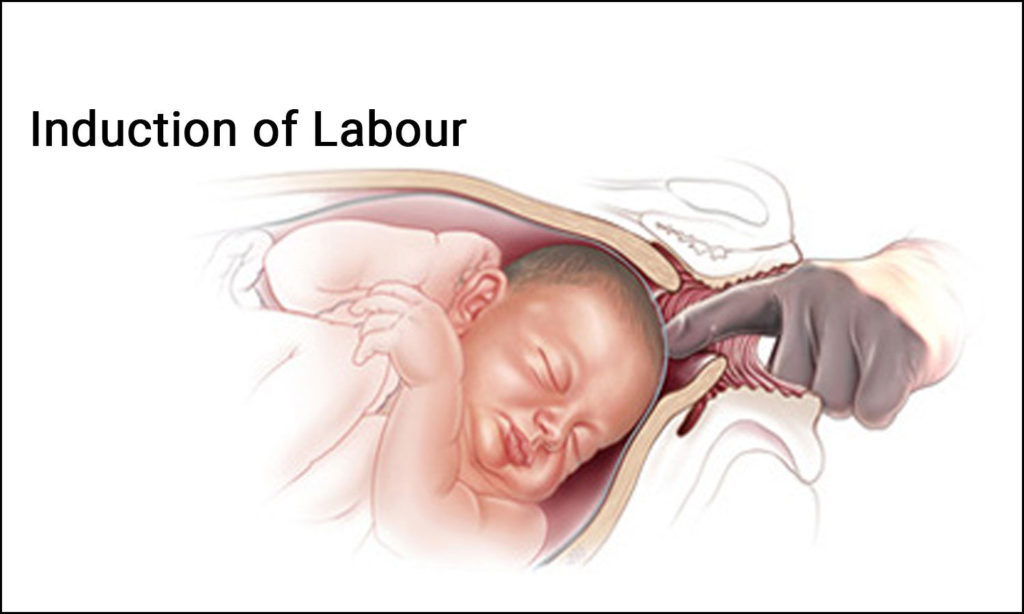Induction labor means initiation of uterine contractions by any method (medical,surgical and compained) for the purpose of vaginal delivery.
Elective induction is the induction of labour in the absence of acceptable fetal or maternal indications.
To determine if labor induction is necessary, including patient health and baby’s health, baby’s gestational age, weight and size, baby’s position in the uterus, and the status of your cervix.
Reasons for labor induction include:
- Postterm pregnancy: More than two weeks of your due date, and labor hasn’t started naturally.
- Prelabor rupture of membranes: Your water has broken, but labor hasn’t begun.
- Chorioamnionitis: Infection in your uterus.
- Fetal growth restriction: The estimated weight of your baby is less than the 10th percentile for gestational age.
- Oligohydramnios: Less amniotic fluid surrounding the baby.
- Gestational diabetes: Increased blood sugar levels during pregnancy.
- High blood pressure disorders of pregnancy: After 20 weeks of pregnancy if the blood pressure increased and that was not before the pregnancy (Gestational hypertension) and if it is before the 20 weeks of pregnancy (chronic high blood pressure)
- Placental abruption: Sudden detachmentof placenta partially or completely from the uterine wall.
- Certain medical conditions: Medical condition such as kidney disease or obesity.
- If the patient is far from the hospital or birthing center or a history of rapid deliveries, a scheduled induction might help you avoid an unattended delivery. In such cases, the gestational age is at least 39 weeks or older before induction to reduce the risk of health problems for baby.
METHODS OF INDUCTION OF LABOR:
- Medical
- Surgical
Depending on the circumstances various kind of method for induction of labor:
MEDICAL:
Mifepristone (progesterone receptor antagonists)(PG)E1
This we can use transvaginaly or orally for induction of labor. A dose of 25 (microgram) vaginally every 4 hours is effective. Maximum 6-8 doses in 24 hours. It is contraindicated in women with previous cesarean birth.
Prostaglandins E2
· Prostaglandins (PG) E2 (dinoprostone) is available in two forms in India for cervical ripening.
i) Dinoprostone gel (3 g gel/0.5 mg dinoprostone) is placed intracervicaly , but not above the internal os. The application can be repeated after 6-8 hours, maximum 3 doses in 24 hours.
ii) Dinoprostone vaginal pessary (10 mg) kept in posterior fornix of the vagina for 24 hours.
· PGE2 has an associated risk of uterine tachysystole and it may lead to higher rates of chorioamnionitis in the setting of ruptured membranes.
· The use of vaginal and intracervical dinoprostone may not be very effective in women with ruptured membranes.
· Both result in a significantly lower cesarean delivery rate and equal success rate, increased proportion of vaginal deliveries within 24 hours.
· Comparatively Vaginal preparations are easier to administer than the intracervical preparation. Intracervical Dinoprostone gel
· The gel should be stored in a refrigerator at ‘2 to 8°C’.
· The application (3 g gel/0.5 mg dinoprostone) can be repeated in 6 hours, not to more than 3 doses in 24 hours.
· Ambulation of the patient is allowed after 30 minutes of insertion
· Temperature, pulse, respiratory rate, blood pressure, uterine activity and vaginal bleeding should are examined immediately after insertion then hourly for 4 – 6 hours.
· If necessary oxytocin for augmentation of labor is started only 6 hours after the last dose.
- Use an intravenous medication. Synthetic version of oxytocin — a hormone that causes the uterus to contract. Oxytocin is more effective at speeding up (augmenting) labor that has already begun than it is as a cervical ripening agent. contractions and baby’s heart rate will be continuously monitored.
How long it takes for labor to start depends on how ripe your cervix is when your induction starts, the induction techniques used and how your body responds to them. If your cervix needs time to ripen, it might take days before labor begins. If you simply need a little push, you might be holding your baby in your arms in a matter of hours.
SURGICAL:
- Artificial Rupture of the amniotic membrane: Also known as an amniotomy, that is makes a small opening in the amniotic sac with a plastic hook. After water breaking patient might feel a warm gush of fluid from the vagina. An amniotomy is done only if the cervix is partially dilated and thinned and the baby’s head is deep in the pelvis. Baby’s heart rate will be monitored regularly before and after the procedure. Doctor has to examine the amniotic fluid whether the fluid mixed with or traces of fecal waste (meconium).
- Stripping the membrane: Digital separation of the chorioamniotic membranes from the wall of the cervix and lower uterine segmants.
MECHANICAL:
- Cervical ripening : Sometimes synthetic prostaglandins are used to thin or soften (ripen) the cervix. After prostaglandin use, Uterine contractions and baby’s heart rate will be monitored.
- Transcervical Balloon catheter: In some other cases small tube ( Foley’s catheter) with an inflatable balloon on the end is inserted into the cervix. The balloon is filled with saline and keeping it against the inside of the cervix helps ripen the cervix.
Indication for LSCS after Induction of labor:
- Failed induction. 75 percent of first-time mothers who are induced will have a successful vaginal delivery. About 25 per of women, who often start with an unripened cervix, might need a C-section.
- Low heart rate: oxytocin or a prostaglandin may produce abnormal or excessive contractions, which can reduce your baby’s oxygen supply and lower your baby’s heart rate.
- Infection: Prolonged membrane rupture increases the risk of an infection for both mother and baby
- Uterine rupture: scar line from a prior C-section might rupture after induction of labor because of strong and frequent uterine contraction. Very rarely, uterine rupture can also occur in women who had never had previous uterine surgery. An emergency C-section is needed to prevent life-threatening complications. Your uterus might need to be removed.
- Bleeding after delivery. Labor induction increases the risk that your uterine muscles won’t properly contract after you give birth (uterine atony), which can lead to serious bleeding after delivery.
Induction of labor should not be an option for :
- A prior C-section with a classical incision or major uterine surgery
- Placenta previa.
- Transverse lie or breech presentation.
- Active genital herpes infection.
- umbilical cord prolapse.
- In most cases induction of labor leads to a successful vaginal birth. If labor induction fails, you might need to try another induction or have a C-section.
- A successful vaginal delivery after induction, there might be no implications for future pregnancies.
Dr.BRUNDHA.





